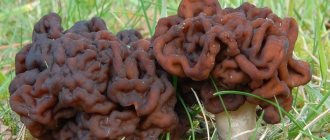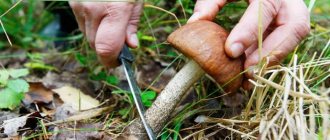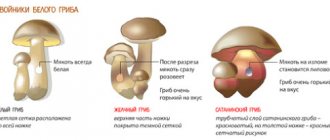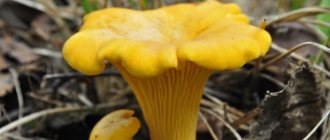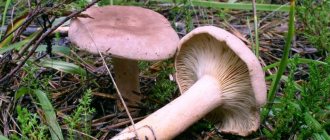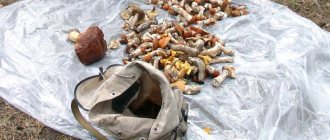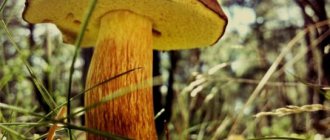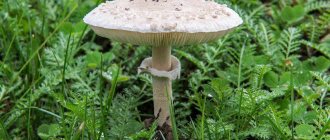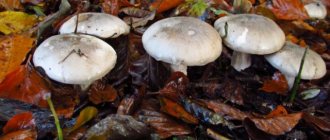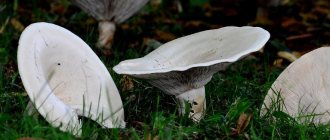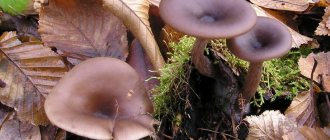Many lovers of “silent hunting” bypass talkers, since among them there are inedible and even poisonous varieties. However, the gray or smoky talker, which is edible, can be called an easily recognizable representative of this family. These mushrooms are quite tasty, large in size and seem to be asking to be picked up. More often they end up in the baskets of already experienced mushroom pickers. For beginners, it is better to first carefully examine the photos of these representatives of the mushroom kingdom from different angles and study their descriptions in detail in order to avoid accidental mistakes during collection.
How to marinate talkers
What you need to marinate talkers
Govorushki - for 1 kilogram Water - half a glass (150 ml) Vinegar 9% - half a glass Salt - 2 tablespoons Cloves - 4 pieces Dill - 30 grams Bay leaf - 2 leaves Ground cinnamon - half a teaspoon Peppercorns - 10 peas Sunflower oil - 30 milliliters
How to marinate talkers
1. Clean the talkers from litter and wash them. 2. Place the mushrooms in a saucepan and add water. 3. Boil the talkers in the marinade: add vinegar and salt to the water. 5. Add seasonings to the marinade. 6. Cool the mushrooms. 7. Place the mushrooms in a jar and pour over the marinade.
Edible or not folded talker
Govorushka bent refers to edible mushrooms that necessarily require heat treatment in the form of boiling for 20 minutes. After this, various dishes or healing remedies are prepared from them. Mushrooms can be dried or frozen to preserve their nutritional and taste qualities for a long time.
Did you know? Sometimes groups of talkers are popularly called “witch circles” because of their growth in rings.
The entire mushroom is used for food. The hat has a pleasant aroma and taste. As for the leg, here the opinions of some chefs are divided. Some consider it to be quite tough, while others rate it as tasty as cap, perhaps due to its slight “almond” flavor.
Before you go into the forest for bent talkers, you need to familiarize yourself with important information about the existing poisonous doubles, and there are many of them. The fact is that the mushroom in question is only one of the representatives of the genus of talkers, among which there are many edible and inedible varieties (about 60).
The latter include such talkers as:
- red - it is also called inverted. It is distinguished by its excessively brittle pulp, pungent odor and brown color of the cap;
- waxy - has a white or gray color, the size of the cap does not exceed 8 cm;
- orange - has a thin long stem on which there is an orange cap with internal plates of the same color, characterized by an unpleasant odor;
- grooved - has a convex beige-red cap with wavy edges, and also has a rather unpleasant odor.
To have a better idea of what the poisonous relatives of the tucked-in talker look like, it is better to turn to literature or online resources and study in detail not only the description, but also photographs. Remember that eating inedible mushrooms can cause not only severe poisoning, but also death.
Important! Talking pots can accumulate toxins, so they need to be collected away from contaminated places
—
highways, industrial enterprises and factories.
Risotto with talkers
Products
Govorushki - 1 kilogram Rice (round grain) - 1 cup Chicken broth (can be replaced with chicken cubes) - 4 cups Vegetable oil (olive) - 1 tablespoon Onion - 1 piece Garlic - 2 cloves Fresh pepper - 100 grams Fresh tomatoes - 100 grams Canned corn - 50 grams Canned green peas - 50 grams Salt, black pepper - 1/2 teaspoon Butter - 4 tablespoons Hard cheese (Parmesan) - 1/4 cup Fresh parsley - to taste
How to cook risotto with talkers
1. Clean and cook talkers. 2. Cut the pepper and tomato into 1.5 centimeter cubes. 3. Wash and finely chop the parsley. 4. Grate the cheese on a fine grater. 5. Heat chicken broth. 6. Peel and finely chop the garlic and onion. 7. Put 2 tablespoons of butter and govorushki into a saucepan or stewpan. 8. Fry the talkers for 5-6 minutes with constant stirring over medium heat. 9. Remove the mushrooms from the pan and add vegetable oil, onion and garlic. 10. Fry for 2 minutes, the garlic should become soft. 11. Add rice to the pan and fry it along with the onion and garlic, stirring constantly, for another 5 minutes. 12. Place peas and corn in rice. 13. Add broth gradually, half a glass at a time, stir and wait until it is absorbed into the rice, then add the next half glass. 14. If the broth is over, and the rice is still crunchy in your teeth, add another half a glass of water and, stirring, wait until the rice is completely cooked. 15. After the rice with talkers is ready, turn off the stove and add mushrooms, cheese, butter and parsley to it. 16. Stir and taste. If there is not enough salt, add salt. 17. Serve risotto with talkers in deep bowls.
Advantages and disadvantages of gray talker
Gray (smoky) talker is found in the forest until late autumn, often in significant quantities.
The mushroom has very characteristic features (appearance, smell). It has no resemblance to poisonous and inedible mushrooms.
Gray talker needs preliminary boiling with the obligatory draining of the broth. When boiled, the smell intensifies, becoming unpleasant. This can make the process of cooking the mushroom uncomfortable.
And also the gray talker - a medicinal mushroom. The antibiotic nebularin, named after the species name of the fungus, was found in fresh fruiting bodies.
Nebularin suppresses the development of Koch's bacillus (the causative agent of tuberculosis), as well as pathogenic fungi. It is probably the presence of nebularin that makes it necessary to boil these mushrooms for consumption.
Gray talker also has antitumor activity.
But collecting gray talker near highways or industrial zones is simply dangerous. The fungus actively accumulates heavy metals.
However, this applies to any mushrooms.
Best regards, Alexander Silivanov
Fkusnofacts
— Cooked talkers are very soft in consistency and have a white color and a spicy-sweet taste
.
Store cleaned and dried talkers
Can be kept in the refrigerator for two days in the vegetable drawer.
— The talker has a fruity-floral scent
, making it difficult to confuse it with other mushrooms. This unusual smell is especially noticeable during cooking. These mushrooms are the “champions” of boiling. From a whole pan with a heap of fresh mushrooms, it turns out boiled just to the bottom.
— Its interesting name
This mushroom was obtained due to the shape of the cap, which is similar to the horn of a loudspeaker.
— Gather
These mushrooms are available from June to September.
- Talkers prefer to grow
in deciduous, coniferous and mixed forests. You can also find them on the edges of the forest and in gardens.
species grow in Russia
talkers. They can be edible, conditionally edible (mushrooms that require additional processing), poisonous and even deadly poisonous. There are significantly more of the last in the family of talkers than the first - Only very experienced mushroom pickers can distinguish one species from another, so talkers should be collected with great care. Among the edible talkers, the most common are: gray or smoky talker, funnel-shaped talker, red tucked talker, fragrant and club-footed talker.
— hat
the talker, with a diameter of four to eight centimeters, changes its shape with age. In a young mushroom it is convex, then becomes flat, but in a mature mushroom it can be concave. The color of the cap depends on the type of mushroom. There are quite dense plates on the inside of the cap. In a young talker they are white, then they acquire a light cream tint. The leg is three to nine centimeters high and widens downwards. The color of the leg can be any shade of gray.
- The talkers are rich
minerals, amino acids, vitamins and fiber. When consuming these mushrooms, the functioning of the digestive system is normalized, the immune system is strengthened and the risk of contracting many diseases is reduced.
— Calorie content
govorushek is low - only 30 kcal/100 grams.
Poisonous types of talkers
Particularly dangerous are whitish, grooved, leafy, inverted, weak-smelling and waxy talkers.
Whitish clitocybe is a mushroom that should not be collected or eaten. It has a small cap, slightly depressed. The color of the cap is pale red and pale gray at the edges. The pulp of the fruit attracts with a pleasant aroma reminiscent of a tomato. The fruiting body contains poison (muscarine). You can find the mushroom in Germany, France, Poland, Romania, Russia, Spain, and Portugal. Mushrooms appear in meadows and forests with coniferous trees from mid-summer to early autumn.
The waxy talker is poisonous, with a high concentration of poison. The hat is of medium diameter (6-8 centimeters), painted in dark white shades. The edges of the cap are wave-shaped and raised upward. The leg is low and identical in color to the cap. You can meet a dangerous species in the countries of Eurasia. Grows in forests near rotting leaves, wood and pine needles. Talkers form large groups and practically do not grow alone. You can see “colonies” of dangerous mushrooms from late summer until mid-November.
How to cook soup with talkers
Products
Fresh talkers - 500 grams Carrots - 1 piece Parsley - 3 stems Zucchini - 300 grams Tomato - 2 pieces Green onions - 20 grams Potatoes - 4 pieces
Recipe for soup with talkers
1. Peel, rinse and chop the talkers.
2. Boil talkers in water with added salt. 3. Wash the celery, peel and cut the carrots. 4. Wash the potatoes, peel them and cut them into cubes, 1 centimeter sides. 5. Fry carrots, tomatoes and celery in sunflower oil. 6. Add carrots to the govorushka soup along with onion greens. 7. Cook the govorushka soup for 10 minutes. Serve talker soup with sour cream.
Useful properties of the mushroom
Looking at the chemical composition, one cannot fail to note the benefits of using talkers for the human body as a whole.
- Among the useful properties it is worth highlighting the following:
- improving the functioning of the stomach and intestines;
- strengthening the immune system;
- disinfecting effect;
- reducing the risk of developing cancer cells;
- prevention of viral diseases;
- assistance in the treatment of urolithiasis;
- cleansing the body of harmful substances, including toxins, heavy metal salts and waste;
- healing skin wounds.
Curled talkers can be used in dietary nutrition, as they have a low calorie content - 100 g of product contains only 30 kcal. In addition, this is an excellent alternative to meat for vegetarians, because mushrooms have no less beneficial and nutritious properties.
Is it possible to grow a row yourself?
Since mushrooms often have problems even in field conditions, it will be quite difficult to grow them yourself. Rower is a finicky mushroom that requires proper care, so achieving positive results is very difficult, and in some cases completely unrealistic. To plant edible rows, you should choose a moist area protected from the sun.
How to plant seeds (spores)?
The first thing you should do is go to the forest for a few mushrooms; the main thing is not to confuse an edible mushroom with a poisonous one. You need to choose a young, healthy mushroom without rot, yellow spots and worms. The mushroom caps are cut off and ground into powder; they contain many seeds. After which it should be soaked in potassium permanganate in a ratio of 1 gram per 9 liters of water. Leave for 5 hours.
Spores are planted in a mixture of horse manure, foliage and pine needles or on a substrate of champignon mushrooms. The pre-soaked mass is simply poured onto the bed and covered with substrate on top. Planting is done in the spring in order to get fruits in the fall.
How to grow mycelium (mycelium)?
Seedlings with mycelium can be obtained in several ways:
- Dig in the forest.
- Grow at home.
- Buy from a specialty store.
If you decide to dig in the forest, then it’s easy to do, you just need to find a clearing where these mushrooms grow and dig out the soil around them. A piece of 20 by 10 by 10 centimeters is enough. After which this land is planted in the garden and filled with substrate.
Buying mycelium is quite difficult, since it is rarely found on the market. In addition, there is a danger that the seller will slip in the wrong mycelium or a completely dead one that does not bear fruit.
Contraindications and possible harm
The benefits of smoky talker are not the same for everyone - sometimes the mushroom provokes negative reactions in the body. It is recommended to stop using the product:
- with gastritis with high acidity;
- with peptic ulcer;
- with pancreatitis;
- for severe liver diseases;
- with a tendency to diarrhea;
- with increased intestinal irritability;
- for individual allergies.
The smoky talker should be excluded from the diet during pregnancy and breastfeeding. It should not be offered to children under 14 years of age. Adults should consume small amounts of mushrooms, since in excess quantities the goverushka can provoke poisoning or stomach upset.
Only fruit bodies collected from clean forests are suitable for food use. You cannot harvest smoky talkers near highways and large industrial facilities, garbage dumps and big cities. In the pulp of such fruiting bodies, even at a young age, toxins and heavy metals accumulate, which can lead to chronic disorders and the development of cancer in humans.
Possible harm from the mushroom
The folded talker has no special contraindications. The most important thing is that when collecting, you do not come across a poisonous double that can cause poisoning. Otherwise, you should follow the recommendations for all edible mushrooms. In particular, you should not overuse mushrooms - they contain the protein chitin, which is poorly digested by the body.
Experts in the field of proper nutrition recommend consuming mushrooms no more than 2 times a week. An excess of this substance can cause gastrointestinal diseases. For the same reason, mushrooms should not be given to pregnant and nursing mothers, as well as children under 5 years of age, and older ones - only in small quantities.
- Overeating can also cause such negative reactions as:
- increased bladder tone, characterized by a frequent urge to urinate;
- allergies, which are easily identified by nausea, vomiting, excessive gas formation, and stool disturbances;
- deterioration of the cardiovascular system with the formation of plaques and blood clots.
Fresh wild mushrooms are an excellent product for preparing a variety of recipes, and dishes with talkers will always have a bright, rich aroma and spicy taste. In addition to nutritional value, they have a lot of useful properties, but do not forget that it is important to be able to collect exclusively edible representatives and not abuse them.
Rules for collecting poplar rows
When collecting sandpipers in an artificial poplar strip, you need to pay attention to the distance from busy roads. You need to go deeper into the forest at a distance of at least half a kilometer
If the collection takes place in windbreaks, then you will have to go 1-1.5 km from the road, since harmful substances spread further over the fields.
It is better to collect the poplar variety of rows on a cool day after the rains. Then you can reap a truly large harvest. Only young fruiting bodies should be taken. They have pink hymenophores and caps that have not yet opened.
Attention! Young poplar rows are hiding under the soil. When you find an old specimen, it makes sense to carefully inspect the area around
Popular articles Common spruce Akrokona
Most likely, entire groups of young cottonwoods are hiding under the soil nearby.
When you find an old specimen, it makes sense to carefully examine the area around it. Most likely, entire groups of young poplars are hiding under the soil nearby.
Application in medicine
The study of these mushrooms has revealed many beneficial properties. The govorushka contains both plant and animal proteins, vitamins B2 and B1, and a large number of useful microelements such as zinc, manganese, and copper. In addition, various medicines can be obtained from talkers. These include diatretin, nebularin, clitocybin and others. The use of these drugs makes it possible to treat tuberculosis. Govorushka has pronounced antibacterial properties.
This mushroom contains clitocybin, which makes it possible to use it in the treatment of epilepsy. Like all other mushrooms, govorushka is a low-calorie product and is recommended as a dietary food. These mushrooms have a cleansing and restorative effect on the body, removing waste, toxins and heavy metal salts from it. In folk medicine, decoctions and ointments made from govorushka are used. They have a wound healing effect and help remove stones. To treat respiratory tract infections, extracts from these mushrooms are made.
Among the talkers there are very poisonous varieties, so they are recommended to be collected only by experienced mushroom pickers. In addition, it is not recommended to consume these mushrooms in combination with alcoholic beverages, as this can cause serious poisoning.
For conditionally edible species of talker, it is very important to carry out heat treatment correctly
Description of taste qualities and nutritional value of talkers
Govorushki belong to the fourth category of mushrooms, so there is no need to talk about their outstanding culinary features. As a rule, even edible representatives of the species are bitter. They smell like flour, sometimes dust. Actually, mushrooms of this species are difficult to classify as valuable.
However, they have one important feature. Some species contain a biologically active compound called clitocin, which has antibacterial activity against a number of bacteria pathogenic to humans, such as Bacillus cereus and Bacillus subtilis. A number of studies have shown antibiotic activity against Mycobacterium tuberculosis, typhoid fever (Salmonella typhi), and bovine brucellosis (Brucea abortus). Clytocin is thought to stimulate apoptosis (cell death) in cancer cells. Talkers also contain phenols and flavonoids, which have antioxidant activity.
Description of the mushrooms
The Oryadovaceae/Tricholomaceae family is so named not for its “love” for geometrically correct structures, but for its crowded growth. In one place, mushroom pickers sometimes collect 1.5 buckets. Poplar row is no exception in this regard.
Its Latin name is Tricholoma populinum from the genus Tricholoma. When determining a poplar row from a photo and description, it is better to rely on Latin. In regions, the mushroom is called differently:
- floodplain;
- poplar;
- subtopolevik;
- poplar row;
- sandstone;
- sandpiper;
- spoilers;
- frosties.
These are the same type of poplar rows, and not different mushrooms. But other representatives of the Tricholomaceae family can also be called sandpipers and sandpipers. The fruiting bodies of tricholomas are often “hidden” underground. Hence such strange names.
Attention! Podtopolniks always grow and always grow near poplars. But rows, including poisonous varieties, can be found throughout coniferous and deciduous forests
The real underwater plant belongs to the group of conditionally edible
But rowers, including poisonous varieties, can be found throughout coniferous and deciduous forests. The real underwater plant belongs to the group of conditionally edible ones.
What do flood mushrooms look like?
Often poplar rows look like small mounds of earth. Some fans even look for them using rubber shoes: a hard lump can be clearly felt under the thin sole. Medium-sized leg: 2-10 cm. Most often about 4 cm high. Diameter (2-4 cm) is almost the same along the entire length. Only at the mycelium itself the stalk barely noticeably thickens.
Popular articles Automatic watering for indoor plants - do it yourselfComment! A variant with a thick stem, similar to a highly elongated drop, is possible.
Inside the leg is dense, without cavities, fleshy. The consistency is dry. The color is pinkish-brown (old) or pinkish-white (young). The surface can be smooth or fibrous. Covered with flocculent scales. When pressure is applied, brown spots remain on the stem.
The young topiary has a hemisphere-shaped cap. The edges are thin and curved inwards towards the stem. As it grows, the cap straightens, becomes fleshy and slightly curved. The skin is pinkish-brown. In rainy weather it becomes slippery. Cap diameter 6-12 cm.
The hymenophore of a young tortoiseshell is white; with age, the plates become pinkish-brown. The flesh is white, but under the skin of the cap it has a brownish color. At the break it turns brown. Opinions about the smell vary. Reference books usually indicate the pleasant aroma of fresh flour. But some mushroom pickers believe that the poplar row smells of soap. In fact, there is a high probability that poplar is confused with soap. The latter really smells like fruit soap.
Comment! Regarding the taste, opinions are the same: either mealy or soapy.
And the reason for the discrepancies, apparently, is again confusion.
Where do floodplains grow?
Distributed in southern Russia and Siberia. They are also found in Europe. They live in symbiosis with poplars, so this species can only be found in natural poplar groves and artificial windbreaks.
The peculiarity of the poplar row is that it grows in large groups and is not found in ordinary deciduous forests. It forms a symbiosis with poplars and prefers sandy soil. But due to the fact that the experience of picking mushrooms is usually passed on from generation to generation, confusion often arises with the names. This is how various “false floodplains” appear, but in the photo in this case you can usually see a different row. And it’s also good if this species is edible.
We must remember that this row of poplars is a companion of poplars. Other rows grow in mixed and coniferous forests. Often no less tasty, but not poplar.
When floodplains grow
The collection time for floodplains is mid-August - early October. For harvesting and preparing fresh mushrooms, flood mushrooms are collected young, before the cap has yet opened. The fruiting bodies at this age are hard and contain almost no worms.
Recipes for making Govorushki
Mushrooms Talker
goes well with boiled and fried vegetables. As an example, here are several recipes.
Vinaigrette with Talkers
Boiled and diced potatoes, carrots and beets are mixed with fresh onions, canned peas and pickled Govorushki mushrooms
. You can leave the salad without dressing or season it with sunflower oil (or lemon juice) and salt.
Marinade salad with Govorushki
Pickled or pickled cucumbers are mixed with fresh onions, pickled Govorushki
and seasoned with sunflower or olive oil and salt. It is allowed to add cold boiled potatoes, pickled garlic, and spices.
Toasts with Talkers
The toast is topped with lettuce and finely chopped Govorushki fried with onions. You can sprinkle grated cheese on top.
Vegetable sauté with Govorushki
Simmer onions, potatoes, eggplant (or zucchini), peppers and tomatoes for 15 minutes, then add boiled Govorushki
, salt, pepper, bay leaf and bring to readiness, periodically adding water.
Symptoms of poisoning
If fiber or poisonous talker gets into food, a natural alkaloid penetrates the body.
How quickly it begins its destructive effect depends on the dose of the toxin, the person’s weight and the presence of chronic diseases (liver, gall bladder, pancreas).
In any case, the poison will make itself felt. The clinical picture will differ from ordinary food poisoning.
Fifteen grams of poisonous pulp is enough, and symptoms will appear within twenty minutes:
- Intestinal dysfunction, colic, nausea, vomiting.
- Increasing blood pressure levels to critical levels.
- Difficulty breathing, similar to asthmatic shortness of breath.
- Tachycardia, chills.
- Increased sweating, frequent urination.
Growing at home and in the country
The methods of growing crowded rows are similar to the methods of growing champignons, but this process will still require certain skills. Features of lyophyllum cultivation:
- The room temperature should be 15 °C.
- The most optimal time for breeding rows is May, but autumn is also quite suitable.
- At the dacha, the mushroom is grown in beds, which should be covered with film from the scorching sun and precipitation.
To grow row trees in the country, you need to do the following:
- Mix the substrate with mycelium in a 1:2 ratio, cover with film to ensure high humidity.
- After 2–3 weeks, the crop must be covered with a 5 cm layer of damp soil.
- In a month, the first fruiting bodies will appear on the soil surface.
- After each harvest, it is necessary to make an additional layer of soil of half a centimeter.
- As soon as the temperature drops below 5 °C, the soil with the mycelium is covered with a cloth, and a layer of leaves or straw of at least 10 cm is placed on top.
How to plant rows indoors:
- Ensure the room has a constant temperature of 10–15 °C, an optimal level of humidity, good ventilation and lighting.
- If all conditions are met, after 3–4 weeks the first fruiting bodies will appear on the soil surface.
- You need to carefully harvest the crop and sprinkle the soil with a new layer.
